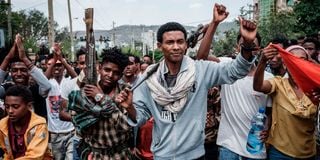TPLF: The party at the heart of Ethiopia's war

Tigray People's Liberation Front (TPLF) fighters are welcomed on a street in Mekele, the capital of Tigray region in June 2021.
What you need to know:
- TPLF was determined to secure self-determination for the Tigray region and its people.
- TPLF grew quickly into an efficient and disciplined organisation that led the armed overthrow of the Derg.
- The party was side-lined from key posts, several leaders were arrested for corruption.
Addis Ababa
From rebels to rulers, dominating government for decades before losing power and returning to the battlefield, the Tigray People's Liberation Front (TPLF) has shaped Ethiopia's history for decades.
Following the decision by Ethiopia's parliament to delist the TPLF as a terrorist organisation, here is a brief history of the group:
Underground years
The TPLF emerged in February 1975 from a feverish and radical student movement which shook an imperial Ethiopia in the 1960s and 70s.
Born as a small guerrilla squad, the TPLF was determined to secure self-determination for the Tigray region and its people within a unified Ethiopia and to right historic grievances.
Emperor Haile Selassie had been overthrown the previous year and the new military Marxist regime known as the Derg brutally crushed the demands of ethno-nationalists.
The TPLF grew quickly into an efficient and disciplined organisation that led the armed overthrow of the Derg.
When different Ethiopian armed groups united under the banner of the Ethiopian People's Revolutionary Democratic Front (EPRDF), it was TPLF chief Meles Zenawi who became its leader.
Meles era
On May 28, 1991, TPLF troops wearing EPRDF uniforms and backed by Eritrean forces seized control of the capital Addis Ababa.
Aged just 36, Meles became Ethiopia's strongman, remaining at the helm until his death in 2012.
Officially, the EPRDF was in charge. But it was the TPLF that held the reins, even though Tigrayans represent only six percent of the population.
After the 1998-2000 war with Eritrea, Meles purged some dissident voices from the TPLF, effectively governing alone.
Slide from power
After Meles' death in 2012 the EPRDF chose Hailemariam Desalegn to become prime minister.
But he lacked the historical legitimacy of the armed struggle, was not Tigrayan, and had no control over the TPLF's military and security apparatus.
Despite Ethiopia's rapid economic growth, nearly 30 years of Tigrayan domination — characterised by a lack of freedom and rampant corruption — fuelled frustration, notably among the two largest ethnic groups, the Oromo and Amhara.
In 2015 a plan to extend the capital into Oromo land sparked protests by both communities, creating a movement which led to the resignation of Hailemariam in February 2018.
Disgrace
The EPRDF chose Abiy Ahmed, an Oromo, to replace him — cementing the TPLF's loss of influence.
The party was side-lined from key posts, several leaders were arrested for corruption, while some sought by the authorities went into hiding in Tigray.
When Abiy decided to scrap the EPRDF in favour of a single political party, the TPLF refused to join and fully retreated to Tigray, defying the authority of the central government.
The party held its own elections in September 2020 despite polls being postponed nationwide due to the coronavirus pandemic.
Conflict
In November 2020, Abiy accused the TPLF of attacking army camps in Tigray and sent troops to disarm and detain the region's dissident leadership.
At the time, the TPLF had a force of some 250,000 fighters, according to the International Crisis Group.
The rebels waged a slow-burn guerrilla insurgency as its top leadership — including chairman Debretsion Gebremichael — went to ground and evaded capture.
The resistance was spearheaded by deposed Tigrayan leaders like Debretsion and seasoned military commanders such as General Tsadkan Gebretensae, who led the Ethiopian army in its bloody war against Eritrea in the late 1990s.
Peace deal
The TPLF mounted a surprise counter-offensive in June 2021 and recaptured Mekele, with Debretsion and rebel fighters arriving in the Tigrayan capital to a heroes' welcome.
Their forces marched onwards into neighbouring regions and even towards Addis Ababa, but were mostly driven back inside Tigray by late 2021.
A humanitarian truce was declared in March 2022 but in August fighting erupted again, with major casualties reported on all sides.
By the time a peace deal was brokered between Addis Ababa and the TPLF in November 2022, Western nations estimated between 100,000 and half a million people had died in two years of bloodshed.
Under the truce the TPLF agreed to disarm in return for the restoration of access to Tigray, and there has been some resumption of basic services and aid deliveries to the stricken region.
In March 2023, the Ethiopian parliament removed the TPLF from an official list of terrorist groups, a key step in the peace process.





